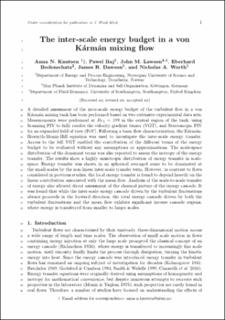| dc.contributor.author | Knutsen, Anna Nina | |
| dc.contributor.author | Baj, Pawel | |
| dc.contributor.author | Lawson, John M | |
| dc.contributor.author | Bodenschatz, Eberhard | |
| dc.contributor.author | Dawson, James | |
| dc.contributor.author | Worth, Nicholas | |
| dc.date.accessioned | 2021-09-24T08:58:58Z | |
| dc.date.available | 2021-09-24T08:58:58Z | |
| dc.date.created | 2020-06-11T09:19:16Z | |
| dc.date.issued | 2020 | |
| dc.identifier.citation | Journal of Fluid Mechanics. 2020, 895 . | en_US |
| dc.identifier.issn | 0022-1120 | |
| dc.identifier.uri | https://hdl.handle.net/11250/2781339 | |
| dc.description.abstract | A detailed assessment of the inter-scale energy budget of the turbulent flow in a von Kármán mixing tank has been performed based on two extensive experimental data sets. Measurements were performed at a Taylor microscale Reynolds number of Re𝜆=199 in the central region of the tank, using scanning particle image velocimetry (PIV) to fully resolve the velocity gradient tensor (VGT), and stereoscopic PIV for an expanded field of view. Following a basic flow characterisation, the Kármán–Howarth–Monin–Hill equation was used to investigate the inter-scale energy transfer. Access to the full VGT enabled the contribution of the different terms of the energy budget to be evaluated without any assumptions or approximations. The scale-space distribution of the dominant terms was also reported to assess the isotropy of the energy transfer. The results show a highly anisotropic distribution of energy transfer in scale space. Energy transfer was shown in a spherically averaged sense to be dominated at the small scales by the nonlinear inter-scale transfer term. However, in contrast to flows considered in previous studies, the local energy transfer is found to depend heavily on the linear contribution associated with the mean flow. Analysis of the scale-to-scale transfer of energy also allowed direct assessment of the classical picture of the energy cascade. It was found that while the inter-scale energy cascade driven by the turbulent fluctuations always proceeds in the forward direction, the total energy cascade driven by both the turbulent fluctuations and the mean flow exhibits significant inverse cascade regions, where energy is transferred from smaller to larger scales. | en_US |
| dc.language.iso | eng | en_US |
| dc.publisher | Cambridge University Press | en_US |
| dc.title | The inter-scale energy budget in a von Kármán mixing flow | en_US |
| dc.type | Peer reviewed | en_US |
| dc.type | Journal article | en_US |
| dc.description.version | acceptedVersion | en_US |
| dc.source.pagenumber | 40 | en_US |
| dc.source.volume | 895 | en_US |
| dc.source.journal | Journal of Fluid Mechanics | en_US |
| dc.identifier.doi | 10.1017/jfm.2020.277 | |
| dc.identifier.cristin | 1814970 | |
| dc.description.localcode | This is the authors' accepted manuscript to an article published by Royal Society of Chemistry. The final authenticated version is available online at: https://doi.org/10.1017/jfm.2020.277 | en_US |
| cristin.ispublished | true | |
| cristin.fulltext | postprint | |
| cristin.qualitycode | 2 | |
